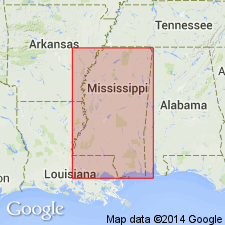
- Usage in publication:
-
- Ripley group
- Modifications:
-
- Named
- Dominant lithology:
-
- Limestone
- Marl
- AAPG geologic province:
-
- Upper Mississippi embayment
Summary:
Ripley group consists of hard crystalline white limestones, generally somewhat sandy, and often glauconitic underlain by black or blue micaceous marls containing well preserved fossils. Thickness 45 to 50 ft. Uppermost Cretaceous formation. Underlies Northern Lignitic group and overlies Rotten limestone group. [According to L.W. Stephenson, the hard crystalline white limestones described by Hilgard as composing upper part of Ripley group are of Eocene (Midway) age, and were separated from the Ripley and named Clayton formation by Langdon in 1891.]
Source: GNU records (USGS DDS-6; Reston GNULEX).
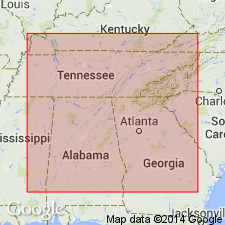
- Usage in publication:
-
- Ripley formation*
- Modifications:
-
- Revised
- Overview
- AAPG geologic province:
-
- Upper Mississippi embayment
Summary:
The typical beds of Ripley formation consist of more or less calcareous and glauconitic sands, sandy clays, impure limestones, and marls of marine origin, reaching estimated maximum thickness of 250 to 350 ft in the eastern Gulf region. Beds rest conformably in part upon Paleozoic rocks, in part upon Eutaw formation (in TN) and in part upon Selma chalk. In some areas Ripley replaces Selma chalk and upper part of Eutaw formation and rests on Tombigbee sand member of Eutaw. Includes McNairy sand member.
Source: GNU records (USGS DDS-6; Reston GNULEX).

- Usage in publication:
-
- Ripley formation*
- Modifications:
-
- Overview
- AAPG geologic province:
-
- Upper Mississippi embayment
Summary:
Later [post-1914] the Owl Creek deposits (which overlie the McNairy sand member of the Ripley in western Tennessee and northeastern Mississippi) were treated as a tongue of Ripley formation. (See L.W. Stephenson, Wash. Acad. Sci. Jour., v. 7, 1917, p. 243-250, and many subsequent reports.) In April 1937 L.W. Stephenson and W.H. Monroe proposed (and USGS adopted): (1) the elevation of Owl Creek to rank of a formation, called Owl Creek formation, and the corresponding restriction of Ripley formation to the beds beneath the Owl Creek and the Prairie Bluff deposits; and (2) the restriction of Selma chalk to the beds underlying the Prairie Bluff, the chalk beds formerly called Oktibbeha tongue of Selma chalk to hereafter be included in Prairie Bluff chalk (redefined) and "Oktibbeha" to be discarded. (See L.W. Stephenson and W.H. Monroe, AAPG Bull., 1937.)
Source: US geologic names lexicon (USGS Bull. 896, p. 1817-1818).
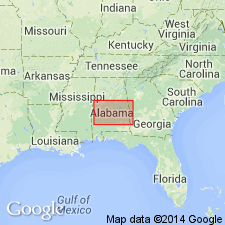
- Usage in publication:
-
- Ripley formation*
- Modifications:
-
- Revised
- AAPG geologic province:
-
- Mid-Gulf Coast basin
- Black Warrior basin
Summary:
In this report, base of formation in eastern AL is placed at base of a thick deposit of coarse sand and gravel rather than at contact of EXOGYRA PONDEROSA and EXOGYRA COSTATA zones as was proposed by Stephenson and Monroe (1938, Am. Assoc. Petroleum Geologists Bull, v. 22, no. 12). This further restricts the Ripley by about 50 ft, but gravel bed, rather than faunal zone contact is more logical base for formation. Proposed restriction has advantage in that base of Ripley is at very nearly the same stratigraphic position from Chattahoochee River to Sumter Co. Conformably overlies Demopolis member of Selma chalk from MS State line through Lowndes Co., but, in eastern part of Sumter Co., uppermost part of Demopolis chalk merges laterally toward the east into sand that is included in Ripley. In western part of Montgomery Co., Ripley rests on westward-extending tongue of Cusseta sand. Unconformably underlies Prairie Bluff chalk. In some areas overlapped by Providence sand.
Source: GNU records (USGS DDS-6; Reston GNULEX).
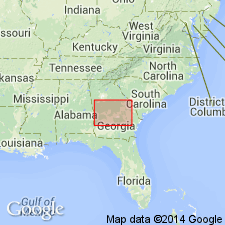
- Usage in publication:
-
- Ripley formation*
- Modifications:
-
- Overview
- AAPG geologic province:
-
- Black Warrior basin
- Mid-Gulf Coast basin
- South Georgia sedimentary province
Summary:
In AL, name Ripley is used in western Sumter Co. for chalky sand and clay beds essentially contemporaneous and continuous with Ripley of MS. Farther east in AL, successively lower parts of Demopolis chalk grade laterally into a sand and clay facies that is designated Ripley. In eastern AL, the Ripley includes all strata between underlying Blufftown formation and overlying Prairie Bluff chalk or its correlative, the Providence sand. Coarse sandy beds at base of Ripley in eastern AL, designated Cusseta sand member, represent western featheredge of Cusseta sand of GA. In GA, name Ripley is applied to sand and sandy clay that contain fossils in upland areas. The strata, originally described as Renfroes marl (Veatch, 1909), lie between Cusseta sand and Providence sand. Report contains detailed description of outcrops in GA.
Source: GNU records (USGS DDS-6; Reston GNULEX).
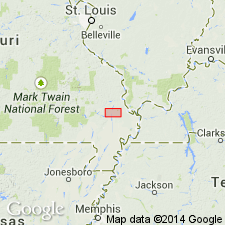
- Usage in publication:
-
- Ripley formation*
- Modifications:
-
- Areal extent
- AAPG geologic province:
-
- Upper Mississippi embayment
Summary:
McNairy sand member of Ripley formation raised in rank to McNairy sand in MO and IL. Because McNairy was only representative of Ripley in these states, the Ripley is geographically restricted.
Source: GNU records (USGS DDS-6; Reston GNULEX).
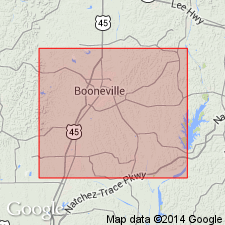
- Usage in publication:
-
- Ripley formation
- Modifications:
-
- Overview
- AAPG geologic province:
-
- Black Warrior basin
Summary:
Ripley formation of this report refers to all beds above Demopolis chalk and consists of three units: transitional clay, Coon Creek tongue, and McNairy sand member. Disconformably underlies Owl Creek and Prairie Bluff formations. Maximum thickness about 300 ft.
Source: GNU records (USGS DDS-6; Reston GNULEX).
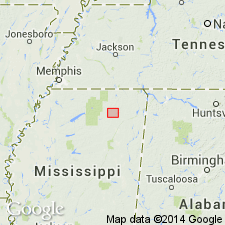
- Usage in publication:
-
- Ripley formation*
- Modifications:
-
- Overview
- AAPG geologic province:
-
- Upper Mississippi embayment
- Black Warrior basin
Summary:
Ripley formation discussed in TN and MS. Thickest in northern areas of outcrop, where, in vicinity of TN-MS State line, it is close to 350 ft thick. Thins southward until near AL-MS State line, it is about 60 ft thick. In northern MS, divided into (ascending) transitional clay, Coon Creek tongue, McNairy sand member, sand of upper part of Ripley, and Keownville limestone member (new). [Keownville later abandoned by Sohl as member is equivalent to Chiwapa, named by Mellen (1958).] Base of formation is gradational downward to Demopolis chalk through transitional clay. In TN and northernmost MS, this clay unit lies entirely within EXOGYRA CANCELLATA zones, but, south of southern Tippah Co., the transitional clay lies in part above that zone. This clay, along with the rest of the formation, grades into sandy chalk in Noxubee Co., MS. Upward, clay becomes increasingly sandy and grades into highly fossiliferous sand units of Coon Creek tongue. In Pontotoc and Kemper Cos., MS, McNairy sand member is absent, and greater part of formation cannot be divided. In Noxubee Co., MS, whole formation grades into chalk facies. Unconformity at top of Ripley varies locally in magnitude. In some places, Keownville limestone member appears to be entirely eroded, and overlying Prairie Bluff chalk rests on sand of middle part of Ripley.
Source: GNU records (USGS DDS-6; Reston GNULEX).
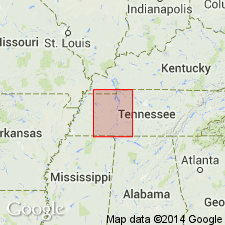
- Usage in publication:
-
- Ripley Formation*
- Modifications:
-
- Revised
- Areal extent
- AAPG geologic province:
-
- Upper Mississippi Embayment
Summary:
Coon Creek Tongue and McNairy Sand Member of the Ripley Formation raised to formational rank in the Mississippi embayment part of western TN according to the usage of the Tennessee Division of Geology, the cooperators of the map. [The Ripley Formation is no longer used on the surface in TN. The Coon Creek and McNairy cannot be distinguished downdip and therefore the Ripley Formation is still used in the subsurface of western TN (Parks, 1978, oral commun).]
Source: GNU records (USGS DDS-6; Reston GNULEX).
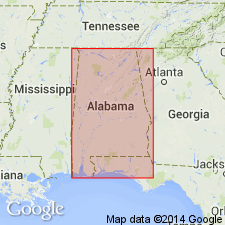
- Usage in publication:
-
- Ripley Formation
- Modifications:
-
- Revised
- AAPG geologic province:
-
- Mid-Gulf Coast basin
Summary:
Ripley Formation here stratigraphically reduced. Cusseta Sand Member of Ripley Formation here raised in rank to Cusseta Sand in AL. Unit also holds formational rank in GA (Pickering and others, 1976). Cusseta is lateral equivalent of the Demopolis Chalk and is separated from the Ripley by a sharp lithic boundary.
Source: GNU records (USGS DDS-6; Reston GNULEX).
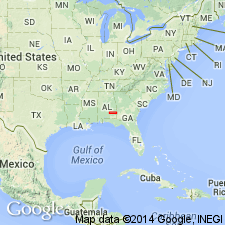
- Usage in publication:
-
- Ripley Formation
- Modifications:
-
- Overview
- Age modified
- AAPG geologic province:
-
- Mid-Gulf Coast basin
Summary:
Based on biostratigraphic data in Sohl and Smith (1980) and Smith and Mancini (1983), stratigraphic breaks at the base of, within, and at the top of the Ripley Formation in AL have been correlated to separate eustatic sea-level drops during the Maastrichtian. (Age then ranges from 74 Ma to 68 Ma.)
Source: GNU records (USGS DDS-6; Reston GNULEX).
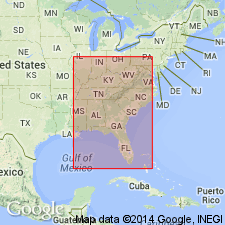
- Usage in publication:
-
- Ripley Formation*
- Modifications:
-
- Age modified
- Biostratigraphic dating
- AAPG geologic province:
-
- Black Warrior basin
- Upper Mississippi embayment
Summary:
Age of Coon Creek Formation (in TN), Coon Creek Tongue of Ripley Formation (in MS), and Ripley Formation (in MS, AL, and GA) is Late Cretaceous (late Campanian and early Maastrichtian) as shown in fig. 1. Age based on CRASSATELLA VADOSA collected from McNairy Co. (southwestern TN), Union and Tippah Cos. (northern MS), Barbour Co. (eastern AL), and Quitman Co. (western GA); BATHYTORMUS PTEROPSIS collected from Union, Tippah, Barbour, and Quitman Cos; and SCAMBULA PERPLANA collected from McNairy, Union, Barbour, and Quitman Cos.
Source: GNU records (USGS DDS-6; Reston GNULEX).
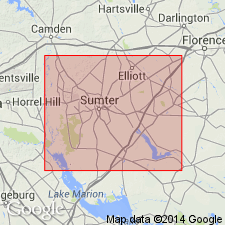
- Usage in publication:
-
- Ripley Formation*
- Modifications:
-
- Overview
- Age modified
- AAPG geologic province:
-
- Mid-Gulf Coast basin
Summary:
Figure 4 of report shows Ripley Formation in AL correlating with Bladen and Donoho Creek Formations of Black Creek Group, and with lower part of Peedee Formation in eastern and central SC. Cusseta Sand Member of Ripley correlates just with Bladen and Donoho Creek. Also shows assignment of Ripley and its Cusseta Sand Member to Tayloran and Navarroan provincial stages.
Source: GNU records (USGS DDS-6; Reston GNULEX).
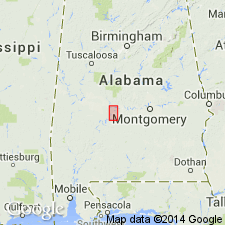
- Usage in publication:
-
- Ripley Formation
- Modifications:
-
- Biostratigraphic dating
- AAPG geologic province:
-
- Mid-Gulf Coast basin
Summary:
In a composite reference section established in this report in Dallas Co., central AL, along the Alabama and Cahaba Rivers, the Tombigbee Sand Member of the Eutaw Formation and the lower 104 ft of the Mooreville Chalk are of late Santonian age as defined by the presence of DICARINELLA ASYMETRICA. The interval from 104 ft above the base of the Mooreville to 265 ft above the base of the Demopolis Chalk is assigned to the GLOBOTRUNCANITA ELEVATA Interval Zone of early to late Campanian age. The upper 95 ft of the Demopolis Chalk and the lower 50 ft of the Ripley Formation are assigned to the G. TRICARINATA Interval zone (early Maastrichtian). The ages of the stratigraphic units defined herein on the basis of a composite reference section in central AL using planktonic Foraminifera and ostracodes agree well with previous studies using calcareous microfossils. However, the ages of the units as published by King and Skotnicki (1992) and King (1993) are not based on any biostratigraphic or chronostratigraphic data and are suspect.
Source: GNU records (USGS DDS-6; Reston GNULEX).
For more information, please contact Nancy Stamm, Geologic Names Committee Secretary.
Asterisk (*) indicates published by U.S. Geological Survey authors.
"No current usage" (†) implies that a name has been abandoned or has fallen into disuse. Former usage and, if known, replacement name given in parentheses ( ).
Slash (/) indicates name conflicts with nomenclatural guidelines (CSN, 1933; ACSN, 1961, 1970; NACSN, 1983, 2005, 2021). May be explained within brackets ([ ]).

